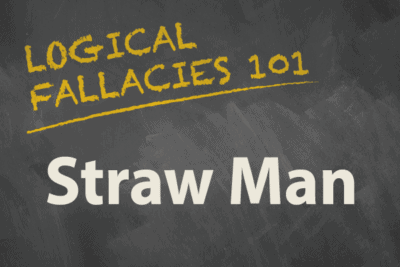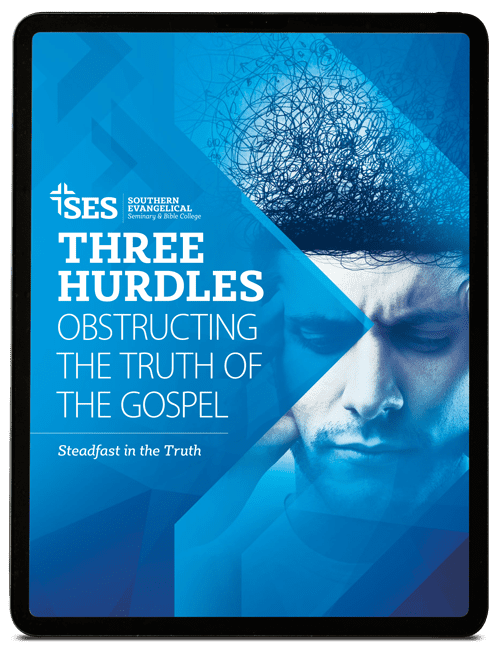Preliminary Comments
Before we continue in the series, it was brought to my attention that there may be some benefit to the readers being exposed to the underlying metaphysics and epistemology upon which an Aristotelian logic is built. Without a doubt, exposure to metaphysical and epistemological realism will make you a better thinker and communicator. However, due to the limitations of this blog series, I would recommend that those who are interested in those foundational principles check out the recommended resources at the bottom of this article. One excellent resource is Peter Kreeft’s book Socratic Logic, which is incredibly practical and provides the basis for the fallacies that are covered in this series. In addition, his book provides a brief discussion on the metaphysics and epistemology of human reason that will fill the gaps that this series has intentionally left unfilled.
If you are a student at SES and would like to contribute an article on the relationship between a realist metaphysic and epistemology as they relate to logic, message our Southern Evangelical Seminary Facebook or our Twitter page @sesapologetics expressing your interest to contribute. If you have questions regarding the impact one’s metaphysics and epistemology have on their use of logic, please post your questions in the comments section on our Facebook page or Tweet us @sesapologetics.
With that being said, let’s discuss the second fallacy in the series, the Fallacy of Amphiboly.
The Fallacy of Amphiboly
Like all forms of equivocation, the presence of amphiboly or grammatical ambiguity can have a serious impact on our communication. An amphiboly is defined by Peter Kreeft in the following quote:
“An ‘amphiboly’ is not an ambiguous word (or phrase) but ambiguous syntax (word order or grammatical structure)” (Kreeft, Socratic Logic, 74).
“I’m having my whole family for dinner,” or “Let’s eat Grandma” are ambiguous sentences due to the sentence structure, grammar, and the concepts involved. In the case of the first sentence, am I having my family over for dinner or am I committing an act of familial cannibalism? The term “family” is not ambiguous, the term “dinner” is not ambiguous, but the use of the preposition “for” makes the relationship between the concepts “family” and “dinner” ambiguous; therefore, the meaning of the entire sentence is now ambiguous. In the case of second sentence, the meaning is skewed due to the poor comma usage. The absence of the comma completely changes the meaning of the sentence. Instead the sentence should read, “Let’s eat, Grandma.”
An analogy of a puzzle is helpful when discussing amphiboly. Think of a sentence as a puzzle and the terms and grammar as the various pieces that must be connected. When the puzzle is completed, there should be an image that is visible and understandable. But when the pieces are forced to fit with pieces to which they don’t correspond, the image becomes muddled. Similarly, the primary cause of amphiboly is due to poor sentence structure, grammar, and their relation to our concepts. Parker and Veatch provide a helpful description of the relationship between our concepts and the words we choose to represent them:
“It is all-important, in the first place, to remember that ambiguity is a disease of word, not of concepts. If it is true to say that most if not all words are ambiguous in some degree, just because their connection with their meanings is artificial, it is also true that no concept is ever ambiguous. . . . Though you may not know whether the word “pen” in this sentence refers to the concept of a writing instrument or to the concept of an enclosure, your concept of a writing instrument is just that, and so also is your concept of an enclosure. Words are ambiguous; concepts never are. Hence our task will be to discover the precise, unambiguous concept which a given word is being used to stand for” (Parker and Veatch, Logic as a Human Instrument, 65-66).
What Parker and Veatch have described is the relationship between words and your concepts. This relationship is why you occasionally “struggle to find the right words . . .“ to describe your concepts; the concept exists in your mind, but the word you need to accurately communicate it escapes you. For example, take the hypothetical conversation between a husband and his wife:
“Honey, remember that store that we visited 6 years ago, on that vacation? I just can’t remember the store’s name; I can see the building, the color of the lettering, the manager that greeted me; they sell shoes and mountain bikes; its located in Santa Cruz, California. But I can’t, for the life of me, remember the store’s name.”
In our example, the concept is not where the issue lies, but it is in the husband’s inability to find the specific word that accurately captures all of his generic descriptions.
In today’s social media culture, it is not uncommon to see people creating ambiguous sentences, either intentionally or unintentionally. For example, “Latest iPhone 8 Leaks Suggest New Battery Strategy.” Are iPhones leaking? What are they leaking, battery acid? Either way, the title is attention grabbing and the presence of ambiguity leads you to investigate further. We saw a similar example in our previous article, on equivocation.
Parker and Veatch found one the best examples of amphiboly in a daily ad in the paper:
“FOR SALE: Antique desk suitable for lady with curved legs and large drawers, also mahogany chest. . . .” In this example none of the individual words [are] ambiguous —at least not to any important degree. Rather the ambiguity which arises from the arrangement, grammar, or syntax of words in sentences is known as amphiboly” (Parker and Veatch, Logic as a Human Instrument, 67; originally cited in the New York Herald Tribune).
While most of these uses are unintentional, amphiboly can be used as a literary device and/or teaching tool. This ambiguity as a teaching tool is seen frequently in the Bible, specifically, wisdom literature.
Ambiguity as Fallacy and Ambiguity as a Device
Using ambiguity intentionally can lead individuals to analyze and reflect on their understanding of the world. This reflection may lead to a deeper knowledge or understanding of a truth or life principle, or it may lead to the realization of our ignorance and instill a new desire for knowledge. Thus, ambiguity is a tool that can be used for evil or for good. Aside from blatant ignorance, ambiguity can be used in several ways. We will primarily discuss the way it is used in teaching, specifically the teachings of Jesus Christ.
The Bible, whether it is the Old Testament or the New Testament, contains passages that are very perplexing and ambiguous. In fact, there are many times during Christ’s ministry where he is intentionally ambiguous and the religious leaders and disciples are perplexed by his teachings (John 2:20-22; 10:1-6; Matt. 13:10). Why did Jesus teach this way? Why wouldn’t he, as the religious leaders asked, “tell us plainly” (John 10:24)?
Jesus’ reason for using the ambiguity is to instill in them a knowledge that they will never forget. It is in wrestling with ambiguity that we obtain a knowledge that is deeply ingrained; spoon fed knowledge is lost as easily as it is obtained. For example, does memorizing passages guarantee that you will understand their meaning? No. Is an 8th grader capable of telling you what the Gettysburg address means by merely memorizing it? No. Likewise just memorizing Bible verses does not guarantee you will absorb the appropriate interpretation and truths. There are plenty of Christians who have an unshakable knowledge of the Gospel because of years of struggling with the text, asking questions about tough passages and striving to live according to its teachings. Thus, it is in the struggle towards truth and our perseverance through challenges that present us with a profound and unshakable knowledge of the truth.
This is why Jesus teaches the way that he does—to ensure that his disciples will not forget his teachings. For example, John 2:19-22 is an example of the syntactical ambiguity that was mentioned above (i.e., amphiboly).
“So the Jews said to him, ‘What sign do you show us for doing these things?’Jesus answered them,‘Destroy this temple, and in three days I will raise it up.’ The Jews then said, ‘It has taken forty-six years to build this temple, and will you raise it up in three days?’But he was speaking about the temple of his body. When therefore he was raised from the dead, his disciples remembered that he had said this, and they believed the Scripture and the word that Jesus had spoken’” (John 2:19-22).
Finally, in Luke 24, we see the ambiguity that was intentionally used during his ministry begin to dissolve as the experience of Christ’s resurrection begins to bear seeds of faith that will inspire the first and greatest generation of Christian missionaries the world has ever seen. Initially we see that the women delivering the spices are confused. They can’t figure out why Jesus’ body is not in the tomb. Then, after being told to remember his teaching, they have an epiphany as they realize the full weight of what Jesus had foretold. The text says of Peter that he “went home and marveled at what had happened” (Luke 24:12). Likewise the men on the road to Emmaus had a similar experience, as they discuss with Jesus (unknowingly) the contents of the Old Testament and their foreshadowing that it was “necessary that the Christ should suffer these things and enter into his glory…” (Luke 24:26-27).
Thus, the use of ambiguity, even the ambiguity of amphiboly, can be used to lead us to a firm foundation in the truth. We should follow the disciples’ example and not be discouraged when we come across a difficult passage or a perplexing riddle in the Holy Scriptures. Rather, we should persevere, continue obtaining tools for study, and trust that when the time is right and the training has been received, we will come to a firm understanding of the truth and be like the disciples after Christ was raised from the dead:
“When therefore he was raised from the dead, his disciples remembered that he had said this, and they believed the Scripture and the word that Jesus had spoken” (John 2:22).
[accordion title =”References”]
Books
Alter, Robert. The Art of Biblical Poetry. New York, NY: Basic Books, INC., Publishers, 1985.
Kreeft, Peter. Socratic Logic: A Logic Text Using Socratic Method, Platonic Questions, and Aristotelian Principles. Edited by Trent Dougherty. 3.1 ed. South Bend, IN: St. Augustine’s Press, 2010.
Parker, Francis H., and Henry Babcock Veatch. Logic as a Human Instrument. New York: Harper, 1959.
URLs
[/accordion]










